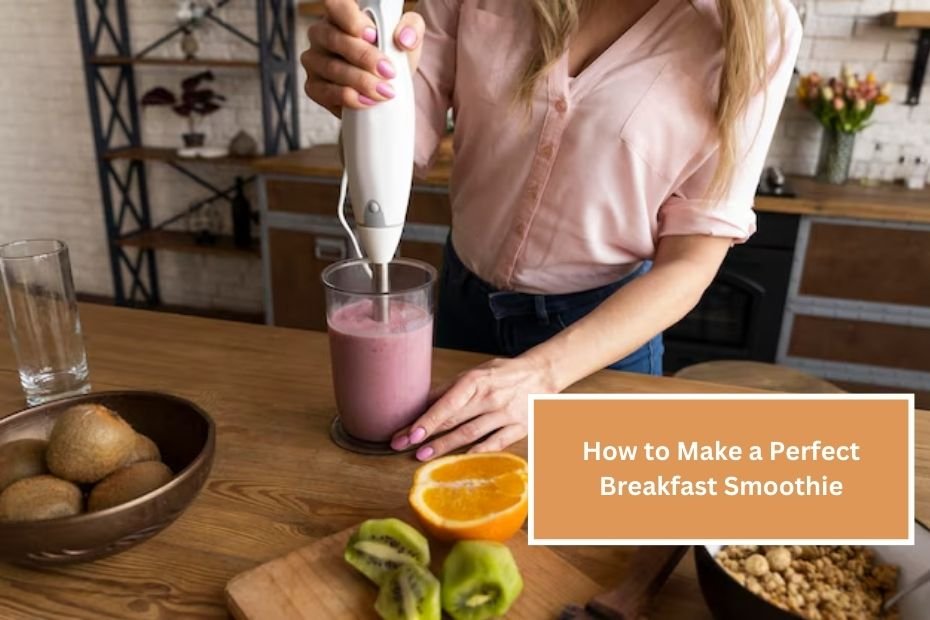Smoothies are one of the most popular breakfast options for people looking to start their day on a healthy and delicious note. They are quick, easy to make, and incredibly versatile. Whether you want a smoothie for energy, weight loss, or just to enjoy a refreshing treat, it can be customized to suit your needs. In this article, we’ll guide you step-by-step on how to make the perfect breakfast smoothie, offer different variations, and provide tips to make your smoothie both nutritious and tasty.
Why Breakfast Smoothies Are a Great Choice
Breakfast is often referred to as the most important meal of the day because it provides the energy and nutrients needed to kickstart your metabolism. Smoothies are an ideal breakfast because they combine fruits, vegetables, proteins, and healthy fats into a single meal that can be enjoyed on the go. Here are a few reasons why breakfast smoothies are great:
- Convenient and Quick: You can blend a smoothie in under five minutes, making it a perfect option for busy mornings.
- Nutrient-Rich: A well-balanced smoothie can provide fiber, protein, vitamins, and minerals, helping you meet your daily nutritional needs.
- Customizable: Smoothies can be tailored to your taste preferences, dietary restrictions, or specific health goals.
- Easy on Digestion: Smoothies are blended, making them easier for your body to digest and absorb the nutrients.
Essential Ingredients for a Perfect Breakfast Smoothie
To make a smoothie that is both satisfying and nutritious, you’ll need a combination of ingredients that provide protein, healthy fats, fiber, and vitamins. Here’s a breakdown of the essential elements that go into a smoothie:
1. Fruits
Fruits are the foundation of most smoothies. They add natural sweetness, flavor, and important nutrients like vitamins, antioxidants, and fiber. Here are some popular fruit choices:
- Bananas: Great for creaminess and potassium.
- Berries (strawberries, blueberries, raspberries): High in antioxidants and low in calories.
- Mangoes and Pineapples: Add a tropical flavor and are rich in Vitamin C.
- Apples and Pears: Provide a crisp texture and additional fiber.
Tip: Use frozen fruits to create a thicker, chilled smoothie without needing ice cubes.
2. Vegetables
For an extra dose of nutrients, adding vegetables to your smoothie is a fantastic idea. Leafy greens are the most popular choice, but there are other vegetables to consider:
- Spinach and Kale: Mild in flavor but packed with vitamins A, C, and K.
- Carrots: Add a touch of sweetness and provide beta-carotene.
- Beets: Earthy flavor and high in antioxidants.
Vegetables are low in calories and can help increase your intake of essential vitamins and minerals without impacting the taste too much.
3. Protein
Adding protein to your smoothie helps keep you full for longer and aids in muscle repair and growth. Here are some great protein options:
- Greek Yogurt: Thick and creamy, rich in protein.
- Protein Powder: Available in various flavors like vanilla or chocolate.
- Nut Butters (peanut butter, almond butter): Adds creaminess and a dose of healthy fats.
- Tofu or Silken Tofu: A great plant-based protein option.
- Chia Seeds or Flax Seeds: Provide protein as well as healthy fats and fiber.
4. Healthy Fats
Including healthy fats in your smoothie makes it more filling and helps with the absorption of fat-soluble vitamins (A, D, E, and K). Here are some good sources of healthy fats:
- Avocado: Adds creaminess without a strong flavor.
- Coconut Oil or MCT Oil: A quick source of energy.
- Nuts and Seeds: Adds texture and extra nutrients.
5. Liquids
The liquid base of your smoothie can change its texture and flavor. You can adjust the amount of liquid based on how thick or thin you want your smoothie to be. Common liquid bases include:
- Almond Milk, Soy Milk, or Coconut Milk: Adds a nutty flavor and creaminess.
- Coconut Water: Refreshing and hydrating, low in calories.
- Water: For a lighter, more refreshing smoothie.
- Fruit Juice: Adds sweetness but can also increase sugar content, so use sparingly.
6. Extras
Once you’ve got your basics down, you can take your smoothie to the next level by adding extras like:
- Honey or Maple Syrup: For added sweetness if needed.
- Cinnamon or Ginger: Spices that enhance the flavor and offer health benefits.
- Oats: For added fiber and texture.
- Cacao Powder: For a chocolatey twist.
Step-by-Step Guide to Making a Breakfast Smoothie
- Choose Your Ingredients: Start by deciding what kind of smoothie you want—fruity, green, protein-packed, etc.
- Add the Liquid: Pour about 1-2 cups of your liquid base into the blender. This ensures that your blender will run smoothly and helps with the blending process.
- Add Fruits and Vegetables: Toss in your chosen fruits and veggies. If you’re using leafy greens like spinach or kale, put them in first to help them blend better.
- Add Protein and Healthy Fats: Scoop in protein powder, Greek yogurt, nut butter, or chia seeds. This will give your smoothie the staying power to keep you full until your next meal.
- Blend: Start the blender on a low setting and gradually increase to high. Blend until everything is smooth, which should take about 30-60 seconds.
- Taste and Adjust: Taste your smoothie to see if you need to adjust the flavor. You can add more liquid if it’s too thick or a sweetener if it’s not sweet enough.
- Serve: Pour your smoothie into a glass and enjoy immediately.
Popular Breakfast Smoothie Recipes
1. Classic Banana and Berry Smoothie
- 1 banana
- 1/2 cup frozen mixed berries
- 1/2 cup Greek yogurt
- 1 tablespoon chia seeds
- 1 cup almond milk
Blend all ingredients together until smooth.
2. Green Energy Smoothie
- 1 handful spinach
- 1/2 avocado
- 1 banana
- 1 tablespoon peanut butter
- 1 cup coconut water
Blend and serve for a nutritious green boost.
3. Tropical Mango Smoothie
- 1 cup frozen mango chunks
- 1/2 cup pineapple
- 1/2 cup coconut milk
- 1 tablespoon flax seeds
- 1 teaspoon honey
Blend for a refreshing tropical taste.
4. Chocolate Protein Smoothie
- 1 scoop chocolate protein powder
- 1 banana
- 1 tablespoon peanut butter
- 1 cup almond milk
- 1 tablespoon cacao powder
Blend for a dessert-like breakfast option that’s still healthy.
Tips for Making the Perfect Smoothie
- Use Frozen Fruits: Frozen fruits help create a thicker, creamier texture without needing ice.
- Balance Sweetness and Nutrients: Aim for a balance between sweetness and nutritional content. Avoid adding too much sugar.
- Layer Ingredients Properly: Place the liquid and softer ingredients at the bottom to help the blender run more efficiently.
- Add Greens Gradually: If you’re new to green smoothies, start by adding small amounts of spinach or kale to avoid overpowering the taste.
- Experiment: Don’t be afraid to try new combinations of ingredients. Some of the best smoothies are created through experimentation!
Conclusion
Breakfast smoothies are an excellent way to start your day with a nutritious and satisfying meal. By including a variety of fruits, vegetables, proteins, and healthy fats, you can create smoothies that are tailored to your needs and taste preferences. Whether you want a quick energy boost, a meal replacement, or just something refreshing, smoothies can be easily adapted to fit into your daily routine.
Making a perfect breakfast smoothie doesn’t require any special skills or fancy ingredients—just a bit of creativity and a blender. So next time you’re in a rush or just want a healthy meal that’s easy to prepare, try blending up a smoothie using the tips and recipes above!

